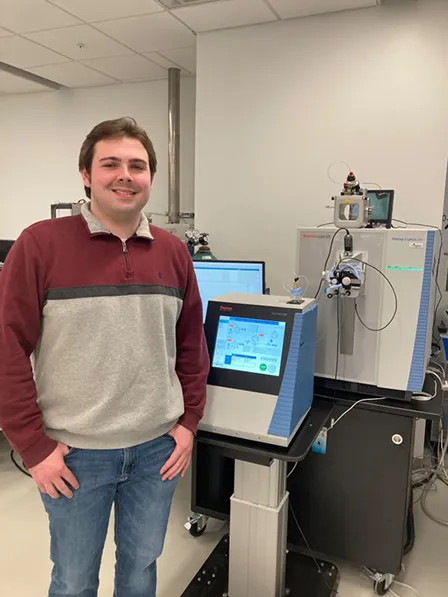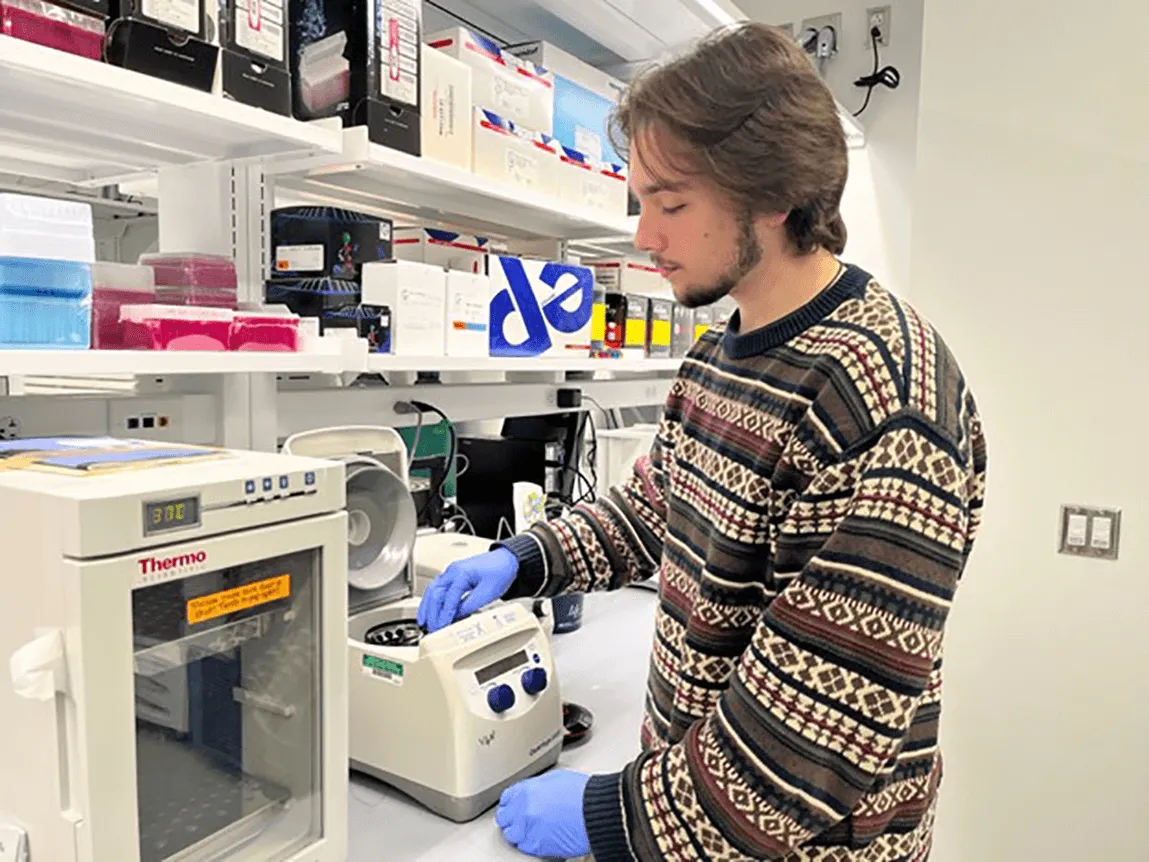Meet the Proteomics Facility’s Spring 2023 interns, Lucas Leon and Brian Boyle. Lucas is a junior Biology major at UVM and Brian is a senior Biochemistry major. The pair work at the Proteomics Core Facility, where Lucas started his internship last fall and Brian joined the team this spring.
The Proteomics Facility is unlike other labs on UVM’s Campus. Rather than being dedicated to new research at UVM, the Proteomics Core Facility is part of the NIH-supported Vermont Biomedical Research Network (VBRN) (www.vbrn.org). The lab’s goal is to help scientists across the state of Vermont and beyond perform experiments they wouldn’t otherwise be able to do. Some labs cannot perform these experiments due to a lack of resources to run tests themselves.
As Brian described it, the Proteomics Lab is “not your typical undergraduate research experience. It’s more consultation, or just trying to help people.” He said, “I guess it’s just using the expertise and the instruments in the lab to help as many people as possible with their proteomics-related questions.”
Brian gave a walkthrough of their most recent project, where the pair met with a collaborator from Middlebury College and learned about his research. From there, the duo prepared the sample and ran the mass spectrometer. After taking these measures, Brian said excitedly, “...now we’re finishing up the data analysis and we’re actually going to talk to him today about the results.”

Used every day in the lab, a mass spectrometer is a valuable piece of scientific equipment. Lucas said that some can cost over half a million dollars, and the lab has five of them. He described how the machine sorts out a protein’s peptides by their weights, which are then matched with prior data to determine a protein’s identity.
The interns receive the samples in gel bands. To prepare them for the mass spectrometer, the interns cut the gel bands and perform a trypsin digestion. This process breaks the proteins’ bonds and stretches out the proteins, and they need to do additional manipulations to ensure that the peptides are clean before mass spectrometry analysis. After the interns process the sample through the mass spec, Lucas explains that they use the information they got from their initial consultation with the scientist(s) to determine which proteins are relevant. He said, “you figure out, like, okay, these proteins were just from their fingers, these aren’t significant. But then these ones will have a big effect on whatever part they’re looking at.”
Though mass spectrometry is invaluable in their lab’s protein identification process, it’s able to sort a variety of objects by weight and has numerous applications. “It’s something that can identify almost anything on the molecular level,” Lucas said. He explained that beyond proteomics, the mass spectrometer can help in quality control and the medical field.
Overall, it seemed that both students found the independent nature of the lab to be its biggest strength. Brian said his favorite aspect of working in the facility is its experiential nature. He said, “I feel like normally when you start in a lab, for the first couple of weeks or months, they don’t really trust you a lot. It’s a lot of shadowing, a lot of watching. But they...really let us get hands-on real quick, so it’s been a really good experiential learning process.”
For Lucas, his major takeaway has been that unlike typical academic labs on campus, the Proteomics Facility is a lab where students can gain industry experience. His favorite memory so far has been a presentation he did for the VBRN last fall. Lucas was the lab’s first-ever undergraduate intern, so the presentation served as an opportunity for him to prove himself as an asset to the lab. He said, “they just wanted to know if I’m helping, what I am doing and simply if I was worth the time required to train me.” Though there was pressure, in the end “they really appreciated the presentation, and it was a big step for me to act as a colleague rather than an undergrad, to many professors well known in their field who I had no previous relation to. I thought that was cool.”
As for next steps, upon graduation Lucas plans to become a physician’s assistant and Brian is going to work in proteomics at the Broad Institute and will go to graduate school in the future!
Notes: The facility has recently been relocated to the new space in Firestone Medical Research Building (FMRB 143) as one of the core facilities (Microscopy Imaging Center, Vermont Integrative Genomics Resource, Flow cytometry and Cell Sorting, and Proteomics) of the Center for Biomedical Shared Resources (CBSR).
Vermont Biomedical Research Network is supported through NIH grant P20GM103449 from the IDeA (Institutional Development Award) Networks of Biomedical Research Excellence (INBRE) Program of the National Institute of General Medical Sciences.
APPLY TO BE AN INTERN:
The VBRN Proteomics Core Facility is currently seeking student interns for future semesters. The internship takes place on-campus and requires 80 hours minimum of commitment over each semester. For the first 6 weeks of the semester, students train in the facility. Once prepared, they help to directly improve current proteomics methods in the lab and gain industry experience as consultants and scientists. Click here to see the facility’s website, and click here to learn more about the internship and how to apply. Internship schedules can be flexible. Students should feel free to visit the facility (FMRB 143) and discuss before applying. Students can register for BIOL 190 for internship credits.
**Image photo credit: Julia Williamson and Brian Boyle**
